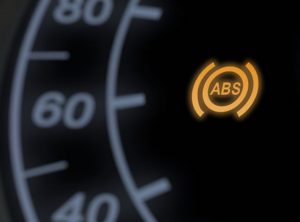The ABS light is on in your car to warn you that there’s either a fault or complete failure with the anti-lock braking system (ABS).
What does ABS do?
When the brake pedal is pressed, brake pads push against rotating brake discs and use friction to slow a vehicle. When the brake pedal is pressed on a vehicle without ABS, constant pressure is applied and under heavy braking, this can result in the wheels locking.

Locked wheels do not steer and so with EU law making it a legal requirement for all new vehicles to be fitted with ABS since 2004, ABS is now fitted as standard.
The anti-lock braking system prevents wheels from locking by using very fast pressure pulses rather than a constant pressure. Sensors constantly monitor the wheels for signs of locking and very quickly increase or decrease pressure to gain optimal braking whilst preventing wheel lock.
ABS helps to prevent locked wheels and skidding under heavy braking or slippery or low-traction road surfaces. Therefore, the system allows for the driver to steer away from danger whilst fully applying the brakes.
Will my Brakes Still Work Without ABS?
ABS is a separate system that is used alongside traditional brakes. If ABS fails on a vehicle, traditional brakes will still work as usual. However, due to the failure of ABS, the potential for locking wheels is significantly increased.
What Should I do if the ABS Light is on?
Have your vehicle repaired as soon as possible and avoid harsh braking, particularly if the road surface is wet or icy. If you do find yourself in an emergency situation which requires heavy braking, use a technique call cadence braking which essentially requires the driver to pump the brake pedal rather than use constant pressure. This is essentially the same technique that ABS uses, although ABS is much faster and much more accurate. This should help to reduce locking wheels and enable the driver to steer the vehicle whilst braking.
ABS Light and Possible Faults
- Low hydraulic brake fluid – This is something you can check yourself. Check levels of the reservoir tank under the bonnet / hood and ensure you put the correct fluid in if it requires topping up. The fluid type will be detailed on the reservoir cap or in the vehicle owners manual. Frequent topping up would indicate that there’s a leak in the braking system.
- Wheel sensors – ABS relies on sensors inside wheel hubs to constantly monitor wheel speed. If the anti-lock braking system determines that one of the wheels is moving slower under braking, hydraulic pressure is released to allow the wheel to move more freely. Due to the sensors being located in an area prone to high heat levels, damage to the sensors can occur.
- Hydraulic pumps and valves – Moving components such as the pumps and valves responsible for increasing or decreasing hydraulic brake fluid pressure can become faulty.
- Wires and pipes – The various wiring and pipes that connect the brakes to the ABS module may corrode, particularly when they are subjected to variable temperature changes and in some instances water.

have had sensors and leads replaced but ABS light still coming on, why and how can it be turned off or reset?